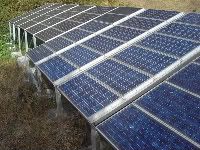From Guest Blogger James Hawkins: Solar in the UK
In April 2010, the UK government introduced their own version of a feed in tariff scheme to help boost our renewable figures and to cut carbon emissions. It is a scheme where homeowners are paid 41.3p for generating electricity with photovoltaic solar panels on their roof, and they are then extra in the case that they don’t use the electricity. Combining the average bill savings with these payments amounts to approximately £1,000 per year at today’s prices. With the scheme lasting for 25 years, the panels will pay themselves off over time, usually 9 to 10 years, and then they will start to generate a healthy income. Our national solar panels company has seen demand for solar skyrocket by over 400% from before the FIT was introduced.
Has this scheme had much success with other companies? The most recent statistics released from the Department of Energy and Climate Change show that photovoltaic use has rocketed. By the end of the second quarter of 2011, the UK’s solar electricity capacity had reached 135MW, an increase of 106MW compared to the end of the first quarter of 2010 – an impressive, but unsurprising, 465% increase due to the new profitability of these systems, with the average system taking about 10 years to pay itself off, and then continuing to generate approximately £1,000pa until 25 years have lapsed since the installation.
Whilst the percentage change is large, it is still questionable whether solar panels are a feature of everyday life in the UK. In total, as of April this year, there are 28,505 domestic solar installations benefiting from the Feed in Tariff in this country. However, this means that if you walk down a street of 100 houses, there is just a 5% chance you’ll see any solar panels – not brilliant, but certainly an improvement from pre-2010.
Regarding renewable energy, these schemes have helped the UK catch up with much of the rest of Europe, where the leading solar-superpower has historically been Germany. By the end of 2006, the UK’s solar capacity amounted to a paltry 0.3% of Europe’s totally solar contributions towards energy usage. Under heavy state funding, Germany’s total amassed to 90% of Europe’s solar power generation, with a relatively enormous 3GWp (Gigawatts Peak). This growth on the Continent is continuing – Italy has just announced plans for 26GW installed capacity by 2016. This is to be aided by their generous Feed In Tariff scheme; Italians get paid 0.43EUR per unit of electricity that they generate, with an additional 30% payment if they have a property certified as energy efficient, and with further regional incentives such as interest free loans, the Italian government have arguably the most attractive financial rewards structure within Europe for encouraging domestic solar installation.
The introduction of community solar projects is a sign of a paradigm shift where people are much more conscious of solar panels, possibly due to the publicity of their significant financial benefits, or possibly due to the publicity of global warming. Photovoltaic systems are not cheap, with domestic systems costing approximately £11,000, and this has led to several large scale group-buying projects. In the USA, the ‘1 Grid Off The Block’ company has had continued success – they contact a solar panel installation company within a particular state and come up with a heavily-discounted price for a certain solar panel system on the proviso that at least a certain number of households sign up to the scheme, which is then advertised across the state to get the homeowners on board.
The UK has yet to see such a broad scale of community installations, although progress is being made on a more local scale. The Ouse valley Energy Service Company (a non-profit organisation) decided to try something similar – they held a meeting to fund-raise for a large solar installation where the dividends could be shared between those investing anything from £250 to £20,000. The directors were “blown away” by the response – 300 people attended the meeting and £307,000 was raised in just six weeks, funding 544 panels, and saving 1,200 tons of CO2 emissions over the expected lifespan of the panels. Since this initiative, despite a slight reduction in payments available for large-scale solar power generation, the Energy Efficiency Financing Scheme and the Renewable Heat Incentive have both been introduced by the government to push for more community-led solar power projects.
Arguments against the current schemes in place are based heavily on their bias towards richer households – only those who can afford solar power can benefit from it. An increase in split ownership projects could bring the benefits to a wider audience and heighten awareness of the environmental issues involving renewable energy generation. The Renewable Heat Incentive, which applies to relatively cheap hot-water-generating solar panels, is a positive first step, but greater action from community groups or the government is necessary for solar to continue being adopted until it reaches a mass scale.
Unfortunately, the government have just announced that in the UK, subsidies will be slashed – from their current high levels of 41.3p per kWh to 21p per kWh. Today is the day that these changes come into place – it’ll be interesting to see if this will devastate the industry, or if the falling prices of panels – the reason for the cut to the subsidy – will mean that households realize solar is still a good investment for those looking for a good return on their clean energy investment dollars.
By James Hawkins, TalkSolarPanels.co.uk.

